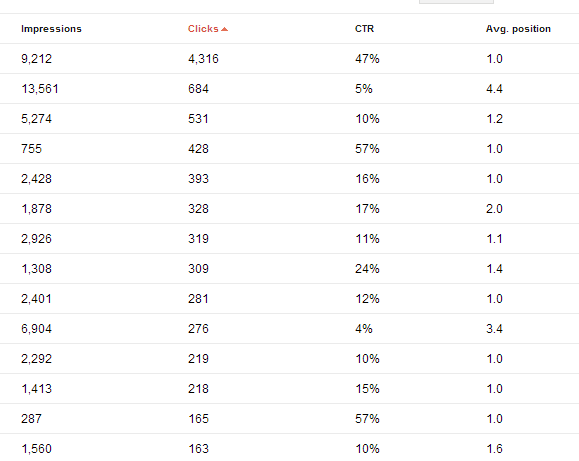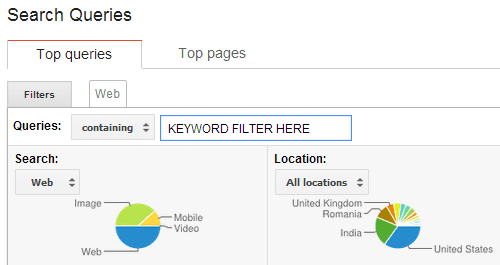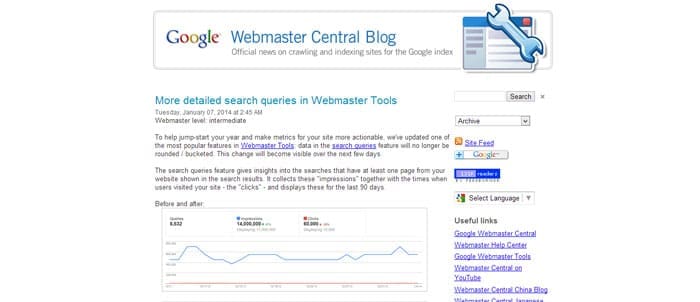Google recently announced that they are sharing more detailed data about search queries in Google Webmaster Tools. It seems that most of the SEO and Internet Marketing world completely overlooked the announcement, so let’s take a quick moment today to look at what this means and why we should all care.
Why Detailed Search Queries on Google Webmaster Tools Matters
In all fairness, the average marketer is not the typical power user of Google Webmaster Tools.
However, everyone from the entry level social media manager to the CMO should be paying attention to the traffic volumes, site health metrics, and conversion rates and volumes on their websites.
During mid-2013, much ado was made about Google’s shift to encrypted search.
The “SEO is dead!” naysayers came out of the woodwork when Google essentially removed all visibility into keyword-level data from Google Analytics.
Smart SEOs and webmasters immediately adjusted several things on their to-do list. They shifted reporting from keyword-only to page-level.
They started to focus more on sources and paths through the site, including overall conversion rate.
In a way, this was a good move if it caused more of us to stop obsessing over ranking and focus on business metrics, no?
But keyword analysis didn’t go away, it just changed. We still had search query data in Google Webmaster Tools, even if the numbers had a large margin of error due to massive rounding on Google’s part.
No longer was there a way to understand precise numbers down to the keyword, especially if you were one to crosstab that with source, location, demographics, or other overall analytics data points.
The new announcement gives us some of that visibility back. We don’t have the micro-level of visibility, but every little bit counts.
SEOs everywhere should be rejoicing at their new window into the data, even if it’s only a fraction of the view we had before.
Bottom line – Google has redrawn the line in a less detailed manner, but they’re throwing us a bone. I’ll take it.
Overview of Google Webmaster Tools Detailed Search Queries
The refresh itself looks to have happened around New Year’s Day 2014, and from what I can see, it may have also impacted data back into 2013.
That’s not much of an issue moving forward.
Google only provides 90 days of reverse vision, so we’ll soon see 2013 drop off the horizon and be running with the new detailed reporting moving forwad.
Based on the GWT announcement, we have very little information about the depth of this change.
As you can see below, they didn’t say much in the announcement itself, so we have to do our own review to understand more. Here’s the excerpt in question:
The search queries feature gives insights into the searches that have at least one page from your website shown in the search results. It collects these “impressions” together with the times when users visited your site – the “clicks” – and displays these for the last 90 days. We hope this makes it easier for you to see the finer details of how users are finding your website, and when they’re clicking through.
Okay, so we can see down to pages with a single impression. That’s great.
If you go into Google Webmaster Tools Search Queries and select the “Top Pages” tab, you can see the full volume of non-rounded metrics for each page.
This is very helpful for those of us who adjusted to content-specific metrics in the absence of keyword data.
But There’s More: Granular Keyword-Level Metrics
With better page-level metrics, we can now access non-rounded metrics on keyword impressions and volumes again.
The below image is an example of how the keyword impression and click volumes appear today.
You can see that they are not rounded and provide much better granularity than we had in the past. (keywords omitted for confidentiality reasons)

The option to view this table “With Changes” still exists, and this is much more valuable for analysis than the broad rounded numbers we saw previously.
Kudos to Google for this change.
Improvement in Filters for Search Queries
Although there was some basic functionality for viewing your search queries data from different angles, you can now use filters on a more granular level as well.
This will enable you to analyze keywords and pages much deeper, providing some “slicing and dicing” for the more analytical among us.
From either the keyword or page view in search queries, you can now drill down by search source / platform (All, Web, Mobile, Image, or Video), Location, or even page traffic volume (All vs. Pages with 10+ Impressions).
Take a look at a screenshot of this piece from the Top Pages view in Google Webmaster Tools below.

Pretty cool, huh? If you access the filters from the “Top Queries” tab, you can also filter for keywords containing any specific stop words or strings of text.
See below for where to find this feature in the UI.

Summary
It is good to see Google listening when users provide feedback.
Surely they were aware of the uproar in the wake of last summer’s changes to keyword reporting.
Hopefully, now that they are getting their arms around spammers and scammers better, we can start to get back more of the access to data that we need to run a website properly.
Updated December 1, 2025
Tommy Landry
Latest posts by Tommy Landry (see all)
- Local SEO Meets AEO and GEO: How AI Platforms Read Local Authority Signals - December 9, 2025
- What Is an SEO Proposal and What Should It Include? - December 2, 2025
- The Complete Guide to Dental SEO: How Dentists Can Attract More Local Patients Online - November 25, 2025





